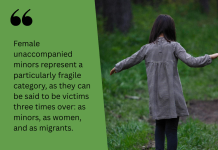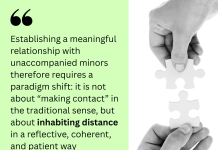In recent decades, Europe has seen a significant increase in unaccompanied migrant children. This increase has led most states to strengthen their reception and protection systems.
According to UNICEF, in 2020, there were 36 million migrant children worldwide, with an increase in the number of children traveling without legally responsible adults. Furthermore, although the formal definition of an unaccompanied minor refers to persons under the age of 18, we must bear in mind that young people aged 19-20-21 may also find themselves in vulnerable and isolated situations.
In this context, female unaccompanied minors represent a particularly fragile category, as they can be said to be victims three times over: as minors, as women, and as migrants.
However, their presence among asylum seekers remains marginal: in 2023, over 90% of applications in Europe came from boys. In the 14-17 age group (the majority of URM), only 2-4% of applications came from girls. Even if there are significant exceptions: for example, unaccompanied girls exceed boys from the Democratic Republic of Congo, and there is also a significant presence from Somalia, Russia, Iraq, and Ethiopia.
European guidelines promote an integrated reception policy, but the gender perspective remains largely unexplored. Research on the subject tends to focus mainly on males, while females seem less visible and more difficult to monitor.
The differences between male and female migration are reflected in various aspects, such as the motivation to migrate (girls often flee violence and abuse, while boys migrate more often for economic reasons) or even traumatic experiences (according to some studies, girls experience trauma before departure, while boys experience it after arrival).
These differences also have implications for mental health. Separation from family at a crucial stage of development, combined with the traumatic experience of the travel and exposure to violence, makes URM one of the most vulnerable groups among asylum seekers.
Gender, considered as a biological and social construct, affects the onset of psychological illness. Evidence shows that unaccompanied girls suffer from depression more often and more profoundly than boys, in line with the general literature on the incidence of depression among women.
Moreover, according to the literature on the subject, women are more exposed to gender-based violence and self-harm, while men are more exposed to substance abuse. Despite this, girls show a greater sense of resilience, adapt better to the school system, and exhibit less aggressive behavior. However, studies on this topic have methodological limitations: there are not many representative studies with balanced samples, as girls are often underrepresented. Furthermore, in most studies, mental health assessments are based on self-administered questionnaires, which may underestimate the actual problems.
In light of this evidence, it is essential that social policies and reception practices are sensitive to gender and nationality, with staff adequately trained to recognize and address specific vulnerabilities. Only in this way will it be possible to guarantee a truly inclusive reception, capable of responding to different migration experiences and promoting the psychosocial well-being of all minors involved.
European Context
In the European context, unaccompanied migrant girls remain a marginal and invisible presence, both in statistical data and in reception policies.
Although their vulnerability is widely recognized, institutions and social services struggle to provide adequate responses. The lack of specific training, intercultural skills, and tools designed to address their needs makes it difficult to provide effective care. Reception protocols remain generic and gender-neutral, ignoring the recommendations of international bodies such as the UNHCR, which have suggested a more sensitive approach to differences.
One of the main obstacles is the scarcity of studies dedicated to unaccompanied migrant girls. Even if there is extensive literature on adult female migration, research on youth migration tends to adopt a neutral perspective.
The low number of girls in reception systems is often interpreted as a marginal fact, but it hides deep cultural dynamics. In their countries of origin, the role of “breadwinner” is traditionally attributed to males, while females are delegated with caring for the family. This patriarchal model discourages girls from migrating independently. In many cases, even when they do leave, they do not really migrate “alone”: they are accompanied by adults who present themselves as relatives but who exercise control on them. Some girls live for years in conditions of invisibility within extended families, until situations of abandonment, neglect, or violence arise.
The identification process is often the responsibility of the law enforcement agencies, while social services only intervene in specific cases. This delay in detection increases the risk of rights violations and impedes access to protection pathways. Once placed in reception centers, girls often find themselves in mixed structures that are not designed to meet their needs. Living alongside boys can cause discomfort, retraumatization, and isolation.
The training of operators is another critical issue. On several occasions, many professionals confirm that the training they receive focuses mainly on boys, and that they lack intercultural skills and tools to understand the specific experiences of girls. This limits their ability to build trusting relationships and offer adequate psychological support. The absence of a gender perspective in reception centers contributes to the vulnerability of girls, who may suffer social pressure and stigmatization.
Behind these narratives of fragility, stories of self-determination also emerge. Many girls migrate by choice, driven by a desire for autonomy, education, and work; for them, migration is a form of emancipation. In some cases, it is women (mothers, sisters, aunts) who encourage departure, helping girls to escape violent environments or forced marriages. In others, however, family networks become risk factors, and adolescents are used as domestic workers in relatives’ homes, a widespread phenomenon that is often not recognized as such.
This ambiguity makes it difficult for operators to distinguish between family reunification and trafficking. Often, girls find themselves in both situations at the same time, forced by adults to hide the truth.
To deal with these complexities, several professionals propose the creation of safe spaces, sensitive to gender, and the inclusion of cultural mediators and female operators capable of establishing deep emotional bonds.
Only an approach that is truly attentive to gender differences and cultural specificities can guarantee unaccompanied migrant girls a fair, effective reception that respects their dignity.
Cyprus context
Cyprus is a key crossroads for migration flows from Europe, Asia, and Africa. Since 2002, the Cypriot government has assumed direct responsibility for the protection of refugees, previously managed by the UNHCR, and among asylum seekers.
Between 2016 and 2022, approximately 3,000 minors applied for protection, with almost half coming from Syria. A significant finding is the stark gender disparity: 93% of minors were boys, while only 7% were girls. Girls are a clear minority in almost all nationalities, with a more visible presence only among Somali minors (26%), and completely absent from countries such as Egypt, Morocco, and Pakistan.
The number of URM has doubled in just a few years, but the reception system has been unable to adapt. Until recently, there was no effective mechanism for correctly identifying minors: age verification was entrusted to the police, without any systematic procedures. Even today, there is a lack of tools to recognize those who arrive with false documents or who have been induced to declare an age over 18. In some police stations, discouraging practices have been reported, such as the absence of interpreters, failure to provide forms, and requests to return several times.
Legal protection is also a problem: there are not enough guardians available, and many minors do not have contact with their representative.
Often, some minors end up in inadequate facilities, similar to those for adults.
In this context, the situation of unaccompanied girls seems even more critical. Their numerical marginality translates into invisibility within the reception system. As a result, many needs remain unspoken, from reproductive health to the management of trauma related to gender-based violence.
Conclusion
The evidence and reflections developed in this article offer an important starting point for reconsidering the practices and knowledge currently adopted in the field of reception of foreign minors, particularly girls. The data clearly show that we cannot take for granted the way people deal with and interpret immigration experiences, especially when it comes to extremely vulnerable individuals. It is essential to focus on people’s subjectivity, recognizing that each individual brings with them unique stories, needs, and resources. Only in this way we can develop a more sensitive, effective, and respectful approach that promotes their psychosocial well-being and real integration, looking beyond generalizations and promoting more inclusive and personalized practices.














